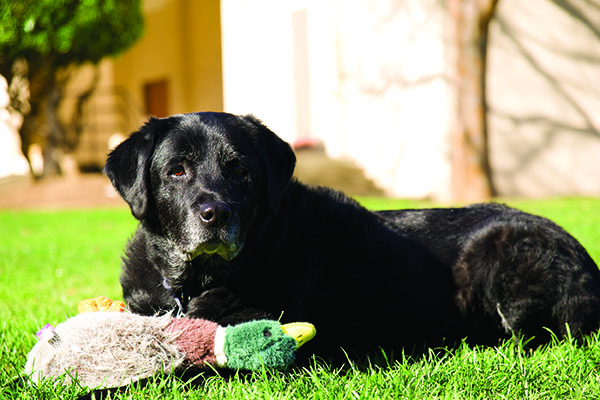A Student’s Best Friend
Within Paly’s high-pressure environment, students have found that service and therapy dogs help reduce stress and improve their overall mental health.

As the bell rings to signal lunchtime at Paly, students flood the quad where volunteers and therapy dogs are ready to offer comfort to all. Service and therapy dogs provide essential help to people all over the world and have made a significant impact on the Paly campus specifically.
“Therapy dogs at Paly allow me to take a break from my day and just take a breather,” junior Corrine Burns said. “One of my favorite moments this year was when the puppy Caramel came to Paly. No matter what is going on in my day, Caramel always brings a smile to my face.”
After extensive training and tests, dogs are equipped with the necessary skills to provide emotional support therapy, relieve stress and serve people with disabilities. Paly is lucky enough to have therapy dogs on campus every Wednesday that provide an outlet for relaxation in the school’s high-pressure environment, a service that students take advantage of weekly.
For a dog to become a therapy dog, they must have good behavior, manners and handling skills. Unlike service and emotional support dogs, therapy dogs are not trained to have a specific owner and instead volunteer in clinical settings to provide comfort, affection and love. Most importantly, they are trained to be comfortable in unfamiliar environments and acclimated to interacting with strangers.
When Beth Martin, coordinator for all volunteering at Paly, adopted her new black lab, Annabelle, she immediately noticed her especially calm demeanor.
“I got Annabelle when she was just a puppy, and she had such a great disposition that it seemed like it would be nice to share with other people,” Martin said. “I’ve had two other dogs and they were not appropriate to be therapy dogs.”
With the help of an experienced therapy dog owner, Martin recognized that Annabelle’s behaviors would be a great fit for a therapy dog and was recommended to get Annabelle certified.
“I had to go through a whole day reviewing the philosophy that there are clear distinctions between therapy and service dogs and we can’t take therapy dogs everywhere,” Martin said. “Annabelle had basic obedience testing like responding to sit, stay, come and had to be familiar and comfortable around people with wheelchairs, getting pet hard and being around loud noises.”
After Annabelle received her certification, Martin began taking her to Paly for students to enjoy her calm presence and has now spent seven years coming to Paly’s weekly lunchtime therapy dog sessions.
Annabelle also frequently visits Sand Hill School, a grade school for students with language-based learning differences. During the visits, third graders read to Annabelle which helps them gain confidence and lower their anxiety levels while reading or speaking out to their peers and teachers.
While therapy dogs provide emotional support at places such as hospitals, schools and mental health institutions, service dogs are necessary to the daily lives of people with disabilities.
Service dogs are specific to their owners and trained specially to aid with whatever disability may be affecting them. Typical roles of service dogs include guide dogs to help the blind, hearing dogs to help the deaf and psychiatric dogs who can detect an oncoming psychiatric episode from their owner.
For service dog owner and Paly junior Veronica Brinkley, service dogs have been a part of her whole life. Brinkley’s first service dog, Hunter, was a Siberian Husky.
“Hunter did tasks for my disability like picking up and bringing items, turning on and off lights, closing doors and cabinets, medication retrieval, guiding and deep or light pressure therapy, which means laying on parts of the body and applying deliberate pressure,” Brinkley said.
“Service dogs are incredibly beneficial medical equipment that helps a wide range of disabilities in many different ways.”
-Veronica Brinkley
Hunter was recently retired for issues with anxiety in public. However, Brinkley now trains service dogs and has many other experiences with dogs.
“Service dogs are incredibly beneficial medical equipment that helps a wide range of disabilities in many different ways,” Brinkley said.
Training a service dog is an extensive process, and unfortunately, not all dogs are able to complete the process successfully. However, Brinkley works hard to prepare her dogs to pass the service dog training dog tests.
“I now have a yellow lab puppy that I’m training for ‘Guide Dogs for the Blind,’ an organization that gives fully trained dogs to visually impaired people,” Brinkley said. “I’m also getting another lab in June to train as my second service dog.”
Brinkley is by no means alone in her found companionship and love towards dogs; throughout history, humans have consistently formed unique relationships with canines. This partnership has been ever-evolving and, today, some people like Martin even devote substantial parts of their lives to spreading the value and benefits that dogs can offer.
2019-2020 - Staff Writer







